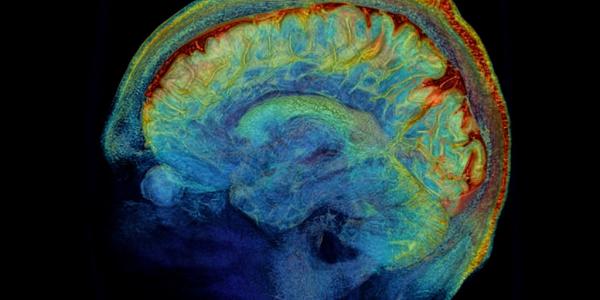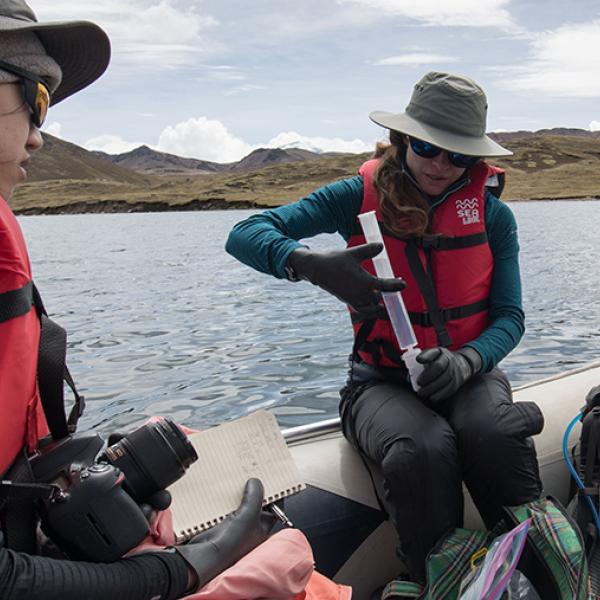Through the groundbreaking Human Connectome Project, researchers like Deanna Barch have spent years mapping the complex wiring of the human brain. Barch, who chairs the Department of Psychological & Brain Sciences at Washington University in St. Louis, provides a behind-the-scenes look into the project and helps us understand the links between brain connectivity and human behavior.
Transcript:
Barack Obama: Now as humans, we can identify galaxies light-years away; we can study particles smaller than an atom. But we still haven’t unlocked the mystery of the three pounds of matter that sits between our ears.
Claire Navarro: Thanks for listening to Hold That Thought. I’m Claire Navarro. The clip you just heard was President Barack Obama in 2013, talking about his commitment to helping scientists learn more about the amazing, mysterious part of the human body called the brain. To continue our series on the brain here on Hold That Thought, in today’s podcast we’re going to be hearing from one such scientist – Deanna Barch.
Deanna Barch: So my name is Deanna Barch, and I am a professor of psychology and psychiatry, and I am the chair of the Department of Psychological and Brain Sciences.
CN: More than 5 years ago, Barch became involved with the Human Connectome Project, a vast effort to map the wiring of the human brain. The project was created to look closely at the connections between how brains work and how we think, feel, and behave.
DB: The interest is really in the idea that the brain and the mind are not separate and that psychological phenomena arise out of the brain.
CN: So five years later, what has the Human Connectome Project revealed about the mind and the brain so far? How do you even go about collecting data for a project like this? And where does the research go from here? Let’s find out.
DB: The Human Connectome Project is an initiative, now started about five and a half years ago, to try to really develop a basic, normative understanding of human brain connectivity, both structural and functional, with the idea that human brain connectivity plays a very important role in individual differences in cognitive function, emotional processing, mental health, neurological disorders, and that we really didn’t have a good, basic understanding of what is the normal variation in human brain connectivity.
CN: By connectivity, Barch is talking about how different parts of the brain work together. Instead of looking at an individual region of the brain and trying to find out what it does and how it works, the Human Connectome Project is more interested in how these parts are connected.
DB: Historically, we have focused a lot on “What does this particular region do and what does this particular region do?” And that is certainly important for understanding behavior, but I think our big focus has been on how important is it in terms of how well these things work together and is working together also critical for understanding variation in behavior.
CN: In this context, there are two main types of brain connectivity. The first is called structural connectivity.
DB: Structural connectivity really refers to the white matter connections between different parts of the brain.
CN: This white matter is made up of myelin, a white substance that covers nerve cell branches. These myelin connections help neurons communicate with each other.
DB: And there can be both short range connections—very local connections, neurons within the same brain region—and then there can be longer pathways that can go farther to the left or the right hemisphere or to the front and the back of the brain.
CN: So that’s structural connectivity. The second type is called functional brain connectivity. This refers to fluctuations in brain activity that seem to be coordinated across different parts of the brain. Sometimes these fluctuations happen when you’re doing a specific kind of activity or task. But they also happen spontaneously, when you’re resting quietly not doing much or thinking about much.
DB: When we look at that coordinated activity, we see sometimes that brain regions that seem to be going together in terms of activity form networks—networks that we think are important for supporting different kinds of cognitive or emotion or memory functions.
CN: Researchers with the Human Connectome project wanted to get lots of data about both structural and functional connectivity. As you might expect, this type of effort takes a lot of, well, brainpower. Barch and her colleagues at Washington University worked with a team of over 38 investigators from 10 institutions around the world. The first part of the project was spent developing new methods and tools for state-of-the-art ways of looking at brain.
DB: And then we spent the next three years on the project actually collecting a very large data set from 1200 individuals where they all went through the same protocol measuring brain structure, brain function, brain connectivity, a whole range of behaviors that are relevant for mental health and education and neurological function. We collected all of that data here at Washington University on a special scanner that we modified for this project.
CN: The 1200 participants each did 4 different scanning sessions. Each round was a little bit different.
DB: In two of the scanning sessions we were taking pictures of brain structure, either structural connectivity or the volume and shape and size of the brain. There we would let them watch movies. They would pick out something they would be interested in, because you are just sitting there and it’s kind of boring if you aren’t doing anything. For the other two scan sessions, when we were looking at functional connectivity in the brain, we asked people to rest quietly and to look at a little cross on the screen and to not think about anything in particular but not fall asleep, ideally.
CN: Evidently, not falling asleep was sometimes harder than it sounds. In some of the other scans, this wasn’t so much of a problem. In those, participants were asked to work their brains a little bit.
DB: We had them doing memory tasks. We had them doing tasks where they were guessing things. We had them listening to language. We had them tapping their fingers and their toes. We had them looking at videos and making some judgments about social interactions, about objects. We had them looking at faces with different expressions. We really had them doing a variety of things, sometimes just relaxing and watching movies, sometimes resting quietly, and sometimes doing these specific tasks that we asked them to do.
CN: So remember, all of this started more than 5 years ago. It’s 2016 now, and at least for those original 1200 participants, data collection is complete. It’s a huge amount of information – both brain imaging scans and behavioral data – and it’s all open to the public.
DB: That’s really a very unprecedented database for understanding in the healthy human what are the typical patterns that we see in terms of brain connectivity, how do individual variations there relate to different aspects of behavior. The idea is that that is sort of forming a basis for additional groups to understand, well, how might things be going awry in people who have different forms of mental illness or Azlheimer’s disease or are aging as a way to try to understand how changes in that connectivity might be contributing to some of these difficulties.
CN: Difficulties like mental illness. Things like depression and schizophrenia. This is something that Barch focuses a lot on in her own lab and research. Recently, her group has found that abnormalities in certain brain networks may help explain some of the challenges faced by people with schizophrenia.
DB: When we think of schizophrenia, we think of things like people hearing voices and having delusions. Those are really critical symptoms of the illness, but we also know that one of the things that really characterizes the illness is challenges in a variety of cognitive domains and that those challenges often make it difficult for people to work and live independently and go to school. Knowing that these alterations in brain connectivity contribute to these problems with memory and thinking and cognitive control helps us begin to understand what might be some of the neural mechanisms causing these difficulties in life for people with schizophrenia.
CN: Over time, this type of information may help scientists and medical professionals work toward treatment and prevention of these kinds of illnesses.
DB: Part of it is we do want to understand the mechanisms, because we think mechanisms will give us clues about potentially effective treatments, genetic influences, those sorts of things. We have also been very interested in understanding whether alterations in connectivity might be good what we refer to as biomarkers for the risk of developing these things. We focused on that a little more in our depression work than in our schizophrenia work with the idea that early intervention is often a very good thing. If you can determine what kids or adolescents are at risk for development of more severe forms of mental illness, you might be able to provide earlier interventions that could be helpful. In some of the work that we are doing with fairly young kids who have early on-set depression we are looking both at brain connectivity and brain activation as potential markers of risk as a way to potentially identify which kids are either most in need of intervention or which kids might most benefit from certain kinds of therapy as a means to try to help those kids get shifted back on to a healthier developmental trajectory than they might otherwise have.
CN: So clearly brain connectivity is hugely important for understanding mental illness, but data from the Human Connectome Project is also revealing how important connectivity is to each and every human brain, even for those people who do not necessarily ever experience mental illness. In one recent study, certain patterns in normal brain connectivity were linked to a wide range of behaviors.
DB: It was lead by one of our colleagues at Oxford, Steve Smith, and what he did was basically say, “Let me try to understand the patterns of brain connectivity. Let me look at all these behavioral metrics, and let’s try to understand if there are some common themes that run across the brain connectivity and behavior and do they relate to each other. And indeed, that’s what he found. It tended to be the case that things like doing well on different memory tasks and cognitive tasks and functioning well in everyday life and not using a lot of substances—those attributes tended to be related to each other and they also tended to be related to this particular pattern of brain connectivity.
CN: For Barch, these kinds of discoveries about the links between brain function and behavior are incredibly valuable. Because at the end of the day, humans are more than a bunch of walking brain scans. It’s our thoughts and actions that make us who we are.
DB: We really need how variation in the brain relates to variations in behavior, because behavior is what allows us to operate in the world. It’s what leads to relationships, jobs, work, and academic performance. From my perspective a critical piece of what makes us who we are as psychologists is that emphasis on understanding how it all contributes to behavior and that being our final endpoint.
CN: Many thanks to Deanna Barch for joining Hold That Thought. For many more ideas to explore, including more on our series in the brains, please visit us at holdthatthought.wustl.edu and Facebook and Twitter or subscribe to our weekly podcasts on iTunes, Stitcher, SoundCloud, or PRX.org. Thanks so much for listening.
Credits:
Audio Free Music Archive: BROKE FOR FREE, CHRIS ZABRISKIE, JARED C. BALOGH, SECRET CIRCUIT





